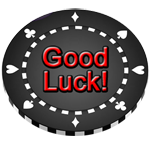Single Table, Multi Table Poker Tournaments
This lesson includes single table and multi table poker tournaments information plus a chip-standing description.
Strictly speaking, a heads-up tournament is just a specialized variant of single table tourney. If you omit satellite qualifier events, where winning a single table tournament automatically gives you an available seat in larger poker tournaments in the real life poker world, you'll find single tournaments almost exclusively held online.
These on-demand tourneys are simple and easy: You sign up, then as soon as the tournament table fills, you are off and playing.
Multi table tournaments are always scheduled tourneys where you sign up early during a registration phase. Occasionally they have caps on the maximum allowable number of players.
The amount of players determines the number of tables in the tourney. Five thousand players in a tournament require 500 tables. When 10 players bust out from the tournament, the poker site breaks down two tables and arranges all the people from that table to the spaces left by the busted out players in a method called rebalancing.
Re-balancing proceeds until the last 10 players remain at the last table.
Although multi table tourneys do exist in the real life poker world, the size of these poker tournaments in the online world is unrivalled.
The most popular poker sites routinely draw tournaments with nearly 6,000 players, particularly if the entry fee is $4 or less.
Based on the huge number of entrants, if excellent playing skill and good luck are on your side, you may take home a few bucks and win.
For example, a $3 entry no-limit Hold ’Em poker tournament paid $1,500 to the winner. A more lucrative tournament, a $200 entry-fee affair, paid $80,000 to the top dog. Not bad for a day’s worth of fun playing poker.
Additionally, you can parlay tournament success online into real life tournament entries.
The final winners of the 2003 and 2004 Poker World Series in Las Vegas won WSOP seats at multi table poker tournaments in the online poker world.
The 2003 winner spent $40 for a tournament that gave a $10,000 entry seat at the WSOP. He ended up grabbing first place in the WSOP and brought home over $2 million in cash.
These examples of parlays for exist in the real life poker world as well, but generally enjoy better popularity in the online poker world.
Chip Standing at Poker Tournaments
Chip standing is essentially your money position compared to everyone else at the tournament. If you are familiar with live tournaments, one of the things that can drive everybody slowly insane is attempting to understand the amount of chips you have compared to everyone else.
Theoretically, players need to keep their tourney chips in plain view. However, players have found many ways to hide their chips: physical obstructions like drinks and hands/arms on the table; huge chip stacks, that conceal yet more chips and untidy chip heaps without definitive valuation. Although you can see other player's chips, you need to be able to evaluate and count them relative to yours.
When playing poker tournaments online, you can get your chip standing instantly. All you need to do is to check the tournament lobby screen to see the full run-down of your standing compared to everyone else including an accurate chip count for the whole tournament.
You will want to pay attention to these four items:
1) Your current chip standing vs. the tournament average stack.
It gives you a better idea of how well you are doing in the tourney. Your standing does not matter much initially in the tournament, but it gets important when you draw close to the money line and when the tournament begins to wear down. It's best that you are no lower than 10% below the average stack. Every time you drop below that level, you need to tighten your playing style and be sure you maximize the winning hands.
2) Your current chip standing vs your opponents at the table.
Your table placement is critical for determining what function you take at the table and what kind of image you need to project.
3) Your current chip standing in the tourney
For example, 8th place out of 115 players. At small tourneys, including single table tourneys on demand, your rank is particularly important because it provides you with an estimation of your standing compared to the rest of the players.
For example, if a player gets an early winning hand and knocks out three opponents, it skews the average. The place where you stand is not as significant early on at large multi table tournaments, even if you get a uncommon rush by winning the first hand in a big multi table tournament and then seeing your rank jump to 1 of 2,000, but it will become critical later on.
Chip standing determines if you are in or out of the cash.
4) Your current chip standing compared to the blinds
If there are fewer than ten big blinds left, you have to drop into the 'short-stack kung fu' mode.
To complete this series, a lesson about re-buys follows
From Poker Tournaments: Single Table, Multi Table lesson, return to Learn Poker Games
OR
Continue with Online Gambling Guide
Gambling Teachers Home
GT is attentive about getting the word out about our free programs, lessons and add-ons offered, however, we ask your assistance and consideration in promoting us.
Click link below that reads, "Enjoy this page? Please pay it forward. Here's how..." to add a link to your site, blog or personal page.
Tips, Terms & Wins
Poker Re-Buys
If you rebuy, you generally don’t need to pay a registration fee. But if the poker rebuy time limit runs out, you are not allowed to take this option and busting out of the tournament permanently eliminates you.





